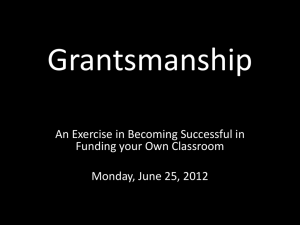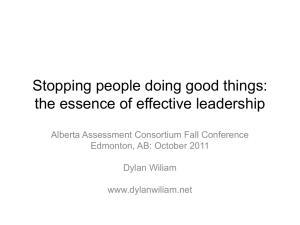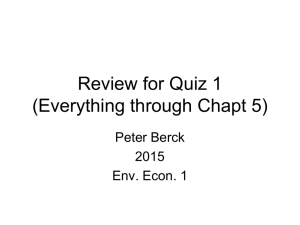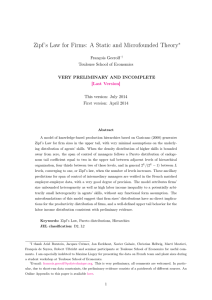Designing teacher learning that benefits students
advertisement
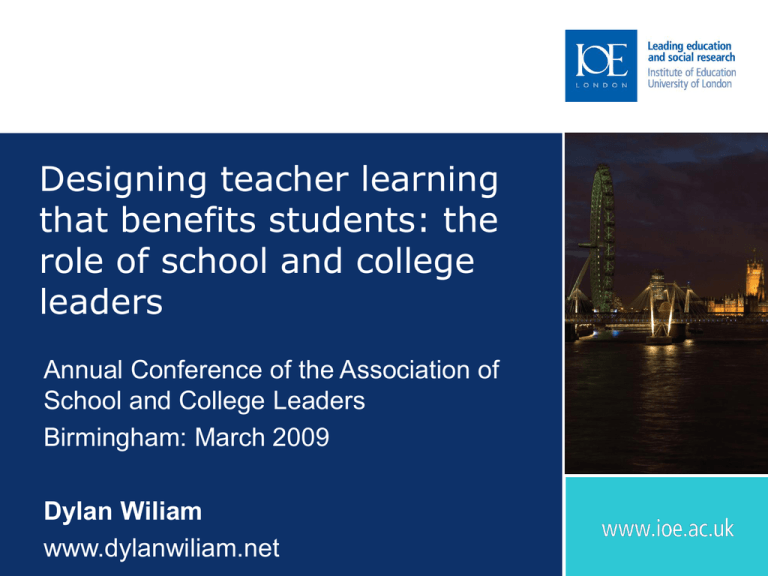
Designing teacher learning that benefits students: the role of school and college leaders Annual Conference of the Association of School and College Leaders Birmingham: March 2009 Dylan Wiliam www.dylanwiliam.net Overview: science and design We need to improve student achievement This requires improving teacher quality Improving the quality of entrants takes too long So we have to make the teachers we have better Science We can change teachers in a range of ways Some will benefit students, and some will not. Those that do involve changes in teacher practice Changing practice requires new kinds of teacher learning And new models of professional development. Design Raising achievement matters For individuals Increased lifetime salary Improved health Longer life For society Lower criminal justice costs Lower health-care costs Increased economic growth Where’s the solution? Structure Small secondary schools ‘All-through’ schools Alignment Curriculum reform National strategies Governance Specialist schools Academies Technology Computers Interactive white-boards School effectiveness Three generations of school effectiveness research Raw results approaches Different schools get different results Conclusion: Schools make a difference Demographic-based approaches Demographic factors account for most of the variation Conclusion: Schools don’t make a difference Value-added approaches School-level differences in value-added are relatively small Classroom-level differences in value-added are large Conclusion: An effective school is a school full of effective classrooms And it’s teachers that make the difference The commodification of teachers has received widespread support: From teacher unions (who understandably resist performance-related pay) From politicians (who are happy that the focus is on teacher supply, rather than teacher quality) But has resulted in the pursuit of policies with poor benefit to cost To see how big the difference is, take a group of 50 teachers Students taught by the best teacher learn twice as fast as average Students taught by the worst teacher learn half as fast average And in the classrooms of the best teachers Students with behavioural difficulties learn as much as those without Students from disadvantaged backgrounds do as well as those from advantaged backgrounds How to make teachers better… Replace existing teachers with better ones Important, but very slow, and of limited impact Raising the bar for entry to teaching (5 percentage points in 30 years) Teach First (at most 1% of teaching force) Improve the effectiveness of existing teachers Not because they are not good enough, but because they can be better (so ‘good enough’ is not good enough) The “love the one you’re with” strategy It can be done Provided we focus rigorously on the things that matter to students Even when they’re hard to do The ‘dark matter’ of teacher quality Teachers make a difference But what makes the difference in teachers? Advanced content matter knowledge Pedagogical content knowledge Further professional qualifications (MA, NBPTS) Total “explained” difference <5% 10-15% <5% 20-25% Cost/effect comparisons Intervention Extra months of learning per year Cost/classroom/yr Class-size reduction (by 30%) 4 £20k Increase teacher content knowledge from weak to strong 2 ? Formative assessment/ Assessment for learning 8 £2k The formative assessment hi-jack… Long-cycle Span: across units, terms Length: four weeks to one year Impact: Student monitoring; curriculum alignment Medium-cycle Span: within and between teaching units Length: one to four weeks Impact: Improved, student-involved, assessment; teacher cognition about learning Short-cycle Span: within and between lessons Length: day-by-day: 24 to 48 hours minute-by-minute: 5 seconds to 2 hours Impact: classroom practice; student engagement Pareto analysis Vilfredo Pareto (1848-1923) Economist, philosopher, etc., associated with the 80:20 rule Pareto improvement A change that can make at least one person (e.g., a student) better off without making anyone else (e.g., a teacher) worse off. Pareto efficiency/Pareto optimality An allocation (e.g., of resources) is Pareto efficient or Pareto optimal when there are no more Pareto improvements QuickTime™ and a TIFF (Uncomp resse d) de com press or are nee ded to s ee this picture. Schools are rarely Pareto optimal Examples of Pareto improvements Less time on marking to spend more time on planning questions to use in lessons Increased use of peer assessment Larger classes with reduced teacher contact time Larger classes with increased teacher salaries Obstacles to Pareto improvements The political economy of reform In professional settings, it is incredibly hard to stop people doing valuable things in order to give them time to do even more valuable things e.g., “Are you saying what I am doing is no good?” e.g., “I care about my kids”. Why is improving classroom practice so hard? Looking at the wrong knowledge… The most powerful teacher knowledge is not explicit That’s why telling teachers what to do doesn’t work What we know is more than we can say And that is why most professional development has been relatively ineffective Improving practice involves changing habits, not adding knowledge That’s why it’s hard And the hardest bit is no getting new ideas into people’s heads It’s getting the old one’s out That’s why it takes time But it doesn’t happen naturally If it did, the most experienced teachers would be the best, and we know that’s not so (Hanushek, 2005) Example: CPR (Klein & Klein, 1981) Six video extracts of a person delivering cardio-pulmonary resuscitation (CPR) 5 of the video extracts are students 1 of the video extracts is an expert Videos shown to three groups: students, experts, instructors Success rate in identifying the expert: Experts: 90% Students: 50% Instructors: 30% Sensory capacity (Nørretranders, 1998) Sensory system Eyes Ears Skin Taste Smell Total bandwidth (in bits/second) 10,000,000 100,000 1,000,000 1,000 100,000 Conscious bandwidth (in bits/second) 40 30 5 1 1 So how do we improve teaching at scale? Teacher learning Teacher learning is just like any other learning in a highly complex area In the same way that teachers cannot do the learning for their learners Leaders cannot do the learning for their teachers Two extreme responses “It’s hopeless” Let a thousand flowers bloom.. Neither will work What leaders can do is engineer effective learning environments for teachers ‘Servant’ leadership Two competing drivers in design Some reforms are too loose e.g., the ‘Effective schools’ movement Allows customization to the local context But can suffer from ‘lethal mutations’ Some reforms are too tight e.g., Montessori Schools Undoubtedly effective Not possible to implement everywhere Fails to capitalize on affordances in the local context Designing for scale: tight but loose “In-principle” scalability requires A single model for the whole school But which honours the specifities of each subject and age-range Understanding what it means to scale (Coburn, 2003) Depth Sustainability Spread Shift in reform ownership Consideration of the diversity of contexts of application Clarity about components, and the theory of action The “tight but loose” formulation … combines an obsessive adherence to central design principles (the “tight” part) with accommodations to the needs, resources, constraints, and particularities that occur in any school or district (the “loose” part), but only where these do not conflict with the theory of action of the intervention. So what do we need? What is needed from teachers A commitment to: the continuous improvement of practice focus on those things that make a difference to student outcomes What is needed from leaders A commitment to: creating expectations for the continuous improvement of practice ensuring that the the focus stays on those things that make a difference to student outcomes providing the time, space, dispensation and support for innovation supporting risk-taking A case study in risk Transposition of the great arteries (TGA) A rare, but extremely serious, congenital condition in newborn babies (~25 per 100,000 live births) in which the aorta emerges from the right ventricle and so receives oxygen-poor blood, which is carried back to the body without receiving more oxygen the pulmonary artery emerges from the left ventricle and so receives the oxygen-rich blood, which is carried back to the lungs Traditional treatment: the ‘Senning’ procedure which involves: the creation of a ‘tunnel’ between the ventricles, and the insertion of a ‘baffle’ to divert oxygen-rich blood from the left ventricle (where it shouldn’t be) to the right ventricle (where it should) Prognosis Early death rate (first 30 days): 12% Life expectancy: 46.6 years The introduction of the ‘switch’ procedure Senning Early death rate Senning 12% Transitional 25% Transitional Switch Bull, et al (2000). BMJ, 320, 1168-1173. Impact on life expectancy Life expectancy: Senning: 46.6 years Switch: 62.6 years





